Gulf Of Mexico
The Gulf of Mexico (Spanish: Golfo de México) is an ocean basin and a marginal sea of the Atlantic Ocean, mostly surrounded by the North American continent.
It is bounded on the northeast, north and northwest by the Gulf Coast of the United States; on the southwest and south by the Mexican states of Tamaulipas, Veracruz, Tabasco, Campeche, Yucatán, and Quintana Roo; and on the southeast by Cuba. The Southern U.S. states of Texas, Louisiana, Mississippi, Alabama, and Florida, which border the gulf on the north, are often referred to as the "Third Coast" of the United States (in addition to its Atlantic and Pacific coasts).
| Gulf of Mexico | |
|---|---|
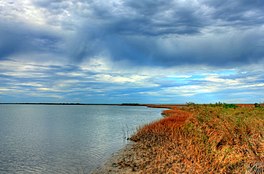 Gulf of Mexico coastline near Galveston, Texas | |
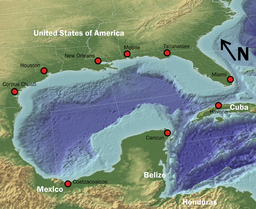 Bathymetry of the Gulf of Mexico | |
| Location | American Mediterranean Sea |
| Coordinates | 25°N 90°W / 25°N 90°W |
| River sources | Rio Grande, Mississippi River, Mobile River, Panuco River, Jamapa River, Pascagoula River, Tecolutla River, Usumacinta River, Apalachicola river |
| Ocean/sea sources | Atlantic Ocean, Caribbean Sea |
| Basin countries | |
| Max. width | 1,500 km (932.06 mi) |
| Surface area | 1,550,000 km2 (600,000 sq mi) |
| Average depth | 1,615 metres (5,299 ft) |
| Max. depth | 3,750 to 4,384 metres (12,303 to 14,383 ft) |
| Settlements | Veracruz, Houston, New Orleans, Corpus Christi, Tampa, Havana, Southwest Florida, Mobile, Gulfport, Tampico, Key West, Cancún, Ciudad del Carmen, Coatzacoalcos, Panama City |

The Gulf of Mexico took shape approximately 300 million years ago as a result of plate tectonics. The Gulf of Mexico basin is roughly oval in shape and is approximately 810 nautical miles (1,500 km; 930 mi) wide. Its floor consists of sedimentary rocks and recent sediments. It is connected to part of the Atlantic Ocean through the Straits of Florida between the U.S. and Cuba, and with the Caribbean Sea via the Yucatán Channel between Mexico and Cuba. Because of its narrow connection to the Atlantic Ocean, the gulf experiences very small tidal ranges. The size of the gulf basin is approximately 1.6 million km2 (615,000 sq mi). Almost half of the basin consists of shallow continental shelf waters. The volume of water in the basin is roughly 2.4×106 cubic kilometers (5.8×105 cubic miles). The gulf is one of the most important offshore petroleum production regions in the world, making up one-sixth of the United States' total production.
Extent
The International Hydrographic Organization defines the southeast limit of the Gulf of Mexico as:
A line joining Cape Catoche Light (21°37′N 87°04′W / 21.617°N 87.067°W) with the Light on Cape San Antonio in Cuba, through this island to the meridian of 83°W and to the Northward along this meridian to the latitude of the South point of the Dry Tortugas (24°35'N), along this parallel Eastward to Rebecca Shoal (82°35'W) thence through the shoals and Florida Keys to the mainland at the eastern end of Florida Bay and all the narrow waters between the Dry Tortugas and the mainland being considered to be within the Gulf.
Geology
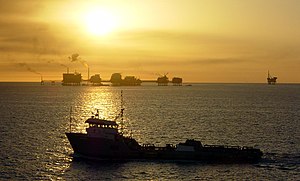


The consensus among geologists is that before the late Triassic, the Gulf of Mexico did not exist. Before the Late Triassic, the area consisted of dry land, which included continental crust that now underlies Yucatán, within the middle of the supercontinent Pangaea. This land lay south of a continuous mountain range that extended from north-central Mexico, through the Marathon Uplift in west Texas and the Ouachita Mountains of Oklahoma, and to Alabama where it linked directly to the Appalachian Mountains. It was created by the collision of continental plates that formed Pangaea. As interpreted by Roy Van Arsdale and Randel T. Cox, this mountain range was breached in the late Cretaceous by the formation of the Mississippi Embayment.
The rifting that created the basin was associated with zones of weakness within Pangaea, including sutures where the Laurentia, South American, and African plates collided to create it. First, there was a late Triassic–early Jurassic phase of rifting during which rift valleys formed and filled with continental red beds. Second, as rifting progressed through early and middle Jurassic times, the continental crust was stretched and thinned. This thinning created a broad zone of transitional crust, which displays modest and uneven thinning with block faulting and a broad zone of uniformly thinned transitional crust, which is half the typical 40-kilometer (25 mi) thickness of continental crust. It was at this time that rifting first created a connection to the Pacific Ocean across central Mexico and later eastward to the Atlantic Ocean. This flooded the opening basin to create an enclosed marginal sea. The subsiding transitional crust was blanketed by the widespread deposition of Louann Salt and associated anhydrite evaporites. During the late Jurassic, continued rifting widened the basin and progressed to the point that seafloor spreading and formation of oceanic crust occurred. At this point, sufficient circulation with the Atlantic Ocean was established that the deposition of Louann Salt ceased. Seafloor spreading stopped at the end of the Jurassic, about 145–150 million years ago.
During the late Jurassic through early Cretaceous, the basin experienced a period of cooling and subsidence of the crust underlying it. The subsidence was the result of a combination of crustal stretching, cooling, and loading. Initially, the combination of crustal stretching and cooling caused about 5–7 km (3.1–4.3 mi) of tectonic subsidence of the central thin transitional and oceanic crust. Because subsidence occurred faster than sediment could fill it, the basin expanded and deepened.
Later, loading of the crust within the basin and adjacent coastal plain by the accumulation of kilometers of sediments during the rest of the Mesozoic and all of the Cenozoic further depressed the underlying crust to its current position about 10–20 km (6.2–12.4 mi) below sea level. Particularly during the Cenozoic, a time of relative stability for the coastal zones, thick clastic wedges built out the continental shelf along the northwestern and northern margins of the basin.
To the east, the stable Florida Platform was not covered by the sea until the latest Jurassic or the beginning of Cretaceous time. The Yucatán Platform was emergent until the mid-Cretaceous. After both platforms were submerged, the formation of carbonates and evaporites has characterized the geologic history of these two stable areas. Most of the basin was rimmed during the early Cretaceous by carbonate platforms, and its western flank was involved during the latest Cretaceous and early Paleogene periods in a compressive deformation episode, the Laramide Orogeny, which created the Sierra Madre Oriental of eastern Mexico.
In 2014, Erik Cordes of Temple University and others discovered a brine pool 3,300 feet (1,000 m) below the gulf's surface, with a circumference of 100 feet (30 m) and 12 feet (3.7 m) feet deep, which is four to five times saltier than the rest of the water. The first exploration of the site was unmanned, using Hercules and in 2015 a team of three used the deep-submergence vehicle Alvin. The site cannot sustain any kind of life other than bacteria, mussels with a symbiotic relationship, tube worms and certain kinds of shrimp. It has been called the "Jacuzzi of Despair". Because it is warmer than the surrounding water (65 °F or 18 °C compared to 39 °F or 4 °C), animals are attracted to it but cannot survive once they enter it.
The Gulf of Mexico is 41 percent continental slope, 32 percent continental shelf, and 24 percent abyssal plain with the greatest depth of 12,467 feet in the Sigsbee Deep. Seven main areas are given as:[citation needed]
- Gulf of Mexico basin contains the Sigsbee Deep and can be further divided into the continental rise, the Sigsbee Abyssal Plain, and the Mississippi Cone.
- Northeast Gulf of Mexico extends from a point east of the Mississippi River Delta near Biloxi to the eastern side of Apalachee Bay.
- South Florida Continental Shelf and Slope extends along the coast from Apalachee Bay to the Straits of Florida and includes the Florida Keys and Dry Tortugas.
- Campeche Bank extends from the Yucatán Straits in the east to the Tabasco–Campeche Basin in the west and includes Arrecife Alacran.
- Bay of Campeche is a bight extending from the western edge of Campeche Bank to the offshore regions east of Veracruz.
- Western Gulf of Mexico is located between Veracruz to the south and the Rio Grande to the north.
- Northwest Gulf of Mexico extends from Alabama to the Rio Grande.
History
Pre-Columbian
As early as the Maya civilization, the Gulf of Mexico was used as a trade route off the coast of the Yucatán Peninsula and present-day Veracruz.
Spanish exploration
This section needs additional citations for verification. (October 2023) |


Although the Spanish voyage of Christopher Columbus was credited with the discovery of the Americas by Europeans, the ships in his four voyages did not reach the Gulf of Mexico. Instead, the Spanish sailed into the Caribbean around Cuba and Hispaniola. The first alleged European exploration of the Gulf of Mexico was by Amerigo Vespucci in 1497. Vespucci is purported to have followed the coastal land mass of Central America before returning to the Atlantic Ocean via the Straits of Florida between Florida and Cuba. However, this first voyage of 1497 is widely disputed, and many historians doubt that it took place as described. In his letters, Vespucci described this trip, and once Juan de la Cosa returned to Spain, a famous world map was produced.
In 1506 Hernán Cortés took part in the conquest of Hispaniola and Cuba, receiving a large estate of land and indigenous slaves for his effort. In 1510 he accompanied Diego Velázquez de Cuéllar, an aide of the governor of Hispaniola, in his expedition to conquer Cuba. In 1518 Velázquez put him in command of an expedition to explore and secure the interior of Mexico for colonization.
In 1517 Francisco Hernández de Córdoba discovered the Yucatán Peninsula. This was the first European encounter with an advanced civilization in the Americas, with solidly built buildings and a complex social organization which they recognized as being comparable to those of the Old World; they also had reason to expect that this new land would have gold. All of this encouraged two further expeditions, the first in 1518 under the command of Juan de Grijalva, and the second in 1519 under the command of Hernán Cortés, which led to the Spanish exploration, military invasion, and ultimately settlement and colonization known as the Conquest of Mexico. Hernández did not live to see the continuation of his work: he died in 1517, the year of his expedition, as the result of the injuries and the extreme thirst suffered during the voyage, and disappointed in the knowledge that Diego Velázquez had given precedence to Grijalva as the captain of the next expedition to Yucatán.
In 1523, a treasure ship was wrecked en route at Padre Island, Texas. When word of the disaster reached Mexico City, the viceroy requested a rescue fleet and sent Ángel de Villafañe from Mexico City, marching overland to find the treasure-laden vessels. Villafañe traveled to Pánuco and hired a ship to transport him to the site, which had already been visited from that community. He arrived in time to greet García de Escalante Alvarado (a nephew of Pedro de Alvarado), commander of the salvage operation, when Alvarado arrived by sea on July 22, 1554. The team labored until September 12 to salvage the Padre Island treasure. This loss, in combination with other ship disasters around the Gulf of Mexico, gave rise to a plan for establishing a settlement on the northern Gulf Coast to protect shipping and more quickly rescue castaways. As a result, the expedition of Tristán de Luna y Arellano was sent and landed at Pensacola Bay on August 15, 1559.
On December 11, 1526, Charles V granted Pánfilo de Narváez a license to claim what is now the Gulf Coast of the United States, known as the Narváez expedition. The contract gave him one year to gather an army, leave Spain, be large enough to found at least two towns of 100 people each, and garrison two more fortresses anywhere along the coast. On April 7, 1528, they spotted land north of what is now Tampa Bay. They turned south and traveled for two days looking for a great harbor the master pilot Miruelo knew of. Sometime during these two days, one of the five remaining ships was lost on the rugged coast, but nothing else is known of it.
In 1697 French sailor Pierre Le Moyne d'Iberville was chosen by the Minister of Marine to lead an expedition to rediscover the mouth of the Mississippi River and to colonize Louisiana which the English coveted. D'Iberville's fleet sailed from Brest on October 24, 1698. On January 25, 1699, d'Iberville reached Santa Rosa Island near Pensacola founded by the Spanish; he sailed from there to Mobile Bay and explored Massacre Island, later renamed Dauphin Island. He cast anchor between Cat Island and Ship Island; and on February 13 he went to the mainland, Biloxi, with his brother Jean-Baptiste Le Moyne de Bienville. On May 1 he completed Fort Maurepas on the northeast side of the Bay of Biloxi. On May 4 d'Iberville sailed for France leaving his teenage brother, Jean-Baptiste Le Moyne, as second in command to the French commandant.
Geography




The Gulf of Mexico's eastern, northern, and northwestern shores lie along the US states of Florida, Alabama, Mississippi, Louisiana, and Texas. The US portion of the coastline spans 1,680 miles (2,700 km), receiving water from 33 major rivers that drain 31 states and 2 Canadian provinces. The southwestern and southern shores lie along the Mexican states of Tamaulipas, Veracruz, Tabasco, Campeche, Yucatán, and the northernmost tip of Quintana Roo. The Mexican coastline spans 1,743 miles (2,805 km). On its southeast quadrant, the gulf is bordered by Cuba. It supports major American, Mexican and Cuban fishing industries. The outer margins of the wide continental shelves of Yucatán and Florida receive cooler, nutrient-enriched waters from the deep by a process known as upwelling, which stimulates plankton growth in the euphotic zone. This attracts fish, shrimp, and squid. River drainage and atmospheric fallout from industrial coastal cities also provide nutrients to the coastal zone.
The Gulf Stream, a warm Atlantic Ocean current and one of the strongest ocean currents known, originates in the gulf as a continuation of the Caribbean Current–Yucatán Current–Loop Current system. Other circulation features include a permanent cyclonic gyre in the Bay of Campeche, as well as anticyclonic gyres which are shed by the Loop Current and travel westward where they eventually dissipate. The Bay of Campeche constitutes a major arm of the Gulf of Mexico. Additionally, the gulf's shoreline is fringed by numerous bays and smaller inlets. Stream that empty into the gulf include the Mississippi River and the Rio Grande in the northern gulf, and the Grijalva and Usumacinta rivers in the southern gulf. The land that forms the gulf's coast, including many long, narrow barrier islands, is almost uniformly low-lying and is characterized by marshes and swamps as well as stretches of sandy beach.
The Gulf of Mexico is an excellent example of a passive margin. The continental shelf is quite wide at most points along the coast, most notably at the Florida and Yucatán Peninsulas. The shelf is exploited for its oil by means of offshore drilling rigs, most of which are situated in the western gulf and in the Bay of Campeche. Another important commercial activity is fishing; major catches include red snapper, amberjack, tilefish, swordfish, and various grouper, as well as shrimp and crabs. Oysters are also harvested on a large scale from many of the bays and sounds. Other important industries along the coast include shipping, petrochemical processing and storage, military use, paper manufacture, and tourism.
The gulf's warm water temperature can feed powerful Atlantic hurricanes causing extensive human death and other destruction as happened with Hurricane Katrina in 2005. In the Atlantic, a hurricane will draw up cool water from the depths and making it less likely that further hurricanes will follow in its wake (warm water being one of the preconditions necessary for their formation). However, the gulf is shallower; when a hurricane passes over the water temperature may drop but it soon rebounds and becomes capable of supporting another tropical storm. From 1970 to 2020, surface temperatures warmed at approximately twice the rate observed for the global ocean surface.
The gulf is considered aseismic; however, mild tremors have been recorded throughout history (usually 5.0 or less on the Richter magnitude scale). Earthquakes may be caused by interactions between sediment loading on the sea floor and adjustment by the crust. On September 10, 2006, the U.S. Geological Survey National Earthquake Information Center reported that a magnitude 6.0 earthquake occurred about 250 miles (400 km) west-southwest of Anna Maria, Florida. The quake was reportedly felt from Louisiana to Florida. There were no reports of damage or injuries. Items were knocked from shelves and seiches were observed in swimming pools in parts of Florida. The earthquake was described by the USGS as an intraplate earthquake, the largest and most widely felt recorded in the past three decades in the region. According to the September 11, 2006 issue of The Tampa Tribune, earthquake tremors were last felt in Florida in 1952, recorded in Quincy, 20 miles (32 km) northwest of Tallahassee.
Maritime boundary delimitation agreements
Cuba and Mexico: Exchange of notes constituting an agreement on the delimitation of the exclusive economic zone of Mexico in the sector adjacent to Cuban maritime areas (with map), of July 26, 1976.
Cuba and United States: Maritime boundary agreement between the United States of America and the Republic of Cuba, of December 16, 1977.
Mexico and United States: Treaty to resolve pending boundary differences and maintain the Rio Grande and Colorado River as the international boundary, of November 23, 1970; Treaty on maritime boundaries between the United States of America and the United Mexican States (Caribbean Sea and Pacific Ocean), of May 4, 1978, and treaty on the delimitation of the continental shelf in the western Gulf of Mexico beyond 200 nautical miles (370 km; 230 mi), of June 9, 2000.
On December 13, 2007, Mexico submitted information to the Commission on the Limits of the Continental Shelf (CLCS) regarding the extension of Mexico's continental shelf beyond 200 nautical miles. Mexico sought an extension of its continental shelf in the Western Polygon based on international law, UNCLOS, and bilateral treaties with the United States, in accordance with Mexico's domestic legislation. On March 13, 2009, the CLCS accepted Mexico's arguments for extending its continental shelf up to 350 nautical miles (650 km; 400 mi) into the Western Polygon. Since this would extend Mexico's continental shelf well into territory claimed by the United States, however, Mexico and the U.S. would need to enter a bilateral agreement based on international law that delimits their respective claims.
Shipwrecks
A ship now called the Mardi Gras sank around the early 19th century about 35 mi (56 km) off the coast of Louisiana in 4,000 feet (1,200 m) of water. She is believed to have been a privateer or trader. The shipwreck, whose real identity remains a mystery, lay forgotten at the bottom of the sea until it was discovered in 2002 by an oilfield inspection crew working for the Okeanos Gas Gathering Company (OGGC). In 2007 an expedition led by Texas A&M University and funded by OGGC under an agreement with the Minerals Management Service (now BOEM) was launched to undertake the deepest scientific archaeological excavation ever attempted at that time to study the site on the seafloor and recover artifacts for eventual public display in the Louisiana State Museum. As part of the project educational outreach Nautilus Productions in partnership with BOEM, Texas A&M University, the Florida Public Archaeology Network and Veolia Environmental produced a documentary about the project, short videos and video updates during the expedition. Video footage from the ROV was an integral part of this outreach and used extensively in the Mystery Mardi Gras Shipwreck documentary.
On July 30, 1942, the Robert E. Lee, captained by William C. Heath, was torpedoed by the German submarine U-166. She was sailing southeast of the entrance to the Mississippi River when the explosion destroyed the #3 hold, vented through the B and C decks and damaged the engines, the radio compartment and the steering gear. After the attack she was under escort by USS PC-566, captained by Lieutenant Commander Herbert G. Claudius, en route to New Orleans. PC-566 began dropping depth charges on a sonar contact, sinking U-166. The badly damaged Robert E. Lee first listed to port then to starboard and finally sank within about 15 minutes of the attack. One officer, nine crewmen and 15 passengers were lost. The passengers aboard Robert E. Lee were primarily survivors of previous torpedo attacks by German U-boats. The wreck's location was discovered during the C & C Marine survey that located the U-166. In 2001 the wreck of U-166 was found in 5,000 feet (1,500 m) of water, less than two miles (3.2 km) from where it had attacked Robert E. Lee.
Biota
Various biota include chemosynthetic communities near cold seeps and non chemosynthetic communities such as bacteria and other micro-benthos, meiofauna, macrofauna, and megafauna (larger organisms such as crabs, sea pens, crinoids, demersal fish, cetaceans, and the extinct Caribbean monk seal) are living in the Gulf of Mexico. Recently, resident Bryde's whales within the gulf were classified as an endemic, unique subspecies and making them as one of the most endangered whales in the world. The Gulf of Mexico yields more fish, shrimp, and shellfish annually than the south and mid-Atlantic, Chesapeake, and New England areas combined.
The Smithsonian Institution Gulf of Mexico holdings are expected to provide an important baseline of understanding for future scientific studies on the impact of the Deepwater Horizon oil spill. In Congressional testimony, Dr. Jonathan Coddington, associate director of Research and Collections at the Smithsonian's National Museum of Natural History, provides a detailed overview of the Gulf collections and their sources which Museum staff have made available on an online map. The samples were collected for years by the former Minerals Management Service (renamed the Bureau of Ocean Energy Management, Regulation and Enforcement) to help predict the potential impacts of future oil/gas explorations. Since 1979, the specimens have been deposited in the national collections of the National Museum of Natural History.
Pollution
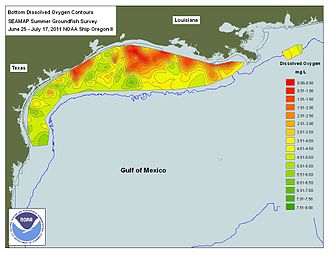
The major environmental threats to the Gulf are agricultural runoff and oil drilling. There are 27,000 abandoned oil and gas wells beneath the gulf. These have generally not been checked for potential environmental problems. In 1973 the United States Environmental Protection Agency prohibited the dumping of undiluted chemical waste by manufacturing interests into the gulf, and the military confessed to similar behavior in waters off Horn Island. Microplastics within semi-enclosed seas like the gulf have been reported in high concentrations, and the gulf's first such study estimated concentrations that rival the highest globally reported.
There are frequent "red tide" algae blooms that kill fish and marine mammals and cause respiratory problems in humans and some domestic animals when the blooms reach close to shore. This has especially been plaguing the southwest and southern Florida coast, from the Florida Keys to north of Pasco County, Florida.
The gulf contains a hypoxic dead zone that runs east–west along the Texas–Louisiana coastline. In July 2008, researchers reported that between 1985 and 2008, the area roughly doubled in size. It was 8,776 square miles (22,730 km2) in 2017, the largest ever recorded. Poor agricultural practices in the northern portion of the Gulf of Mexico have led to a tremendous increase of nitrogen and phosphorus in neighboring marine ecosystems, which has resulted in algae blooms and a lack of available oxygen. Occurrences of masculinization and estrogen suppression were observed as a result. An October 2007 study of the Atlantic croaker found a disproportioned sex ratio of 61% males to 39% females in hypoxic sites. This was compared with a 52% to 48% male-female ratio found in reference sites, showing an impairment of reproductive output for fish populations inhabiting hypoxic coastal zones.
Oil spills
According to the National Response Center, the oil industry has thousands of minor accidents in the Gulf of Mexico every year. In June 1979, the Ixtoc I oil platform in the Bay of Campeche suffered a blowout leading to a catastrophic explosion, which resulted in a massive oil spill that continued for nine months before the well was finally capped. This was the largest oil spill in the Gulf of Mexico to date.
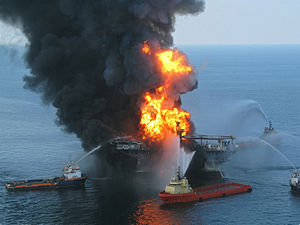
On April 20, 2010, the Deepwater Horizon oil platform, located in the Mississippi Canyon about 40 miles (64 km) off the Louisiana coast, suffered a catastrophic explosion; it sank a day and a half later. It was in the process of being sealed with concrete for temporary abandonment, to avoid environmental problems. Although initial reports indicated that relatively little oil had leaked, by April 24 it was claimed by BP that approximately 1,000 barrels (160 m3) of oil per day were issuing from the wellhead, about 1-mile (1.6 km) below the surface on the ocean floor.
On April 29, the U.S. government revealed that approximately 5,000 barrels (790 m3) per day, five times the original estimate, were pouring into the gulf from the wellhead. The resulting oil slick quickly expanded to cover hundreds of square miles of ocean surface, posing a serious threat to marine life and adjacent coastal wetlands and to the livelihoods of Gulf Coast shrimpers and fishermen. Coast Guard Rear Admiral Sally Brice O'Hare stated that the U.S. government will be "employing booms, skimmers, chemical dispersants and controlled burns" to combat the oil spill.
By May 1 the oil spill cleanup efforts were underway but hampered by rough seas and the "tea like" consistency of the oil. Cleanup operations were resumed after conditions became favorable. On May 27 the USGS had revised the estimate of the leak from 5,000 barrels per day (790 m3/d) to 12,000–19,000 barrels per day (3,000 m3/d) an increase from earlier estimates. On July 15 BP announced that the leak had stopped for the first time in 88 days. In July BP reached an $18.7bn settlement with the U.S. government, the states of Alabama, Florida, Louisiana, Mississippi and Texas, as well as 400 local authorities. To date, BP's cost for the clean-up, environmental and economic damages and penalties has reached $54bn.
On May 12, 2016, a release of oil from subsea infrastructure on Shell's Brutus oil rig released 2,100 barrels of oil. This leak created a visible 2 by 13 miles (3.2 by 20.9 km) oil slick in the sea about 97 miles (156 km) south of Port Fourchon, Louisiana, according to the U.S. Bureau of Safety and Environmental Enforcement.
See also
- American Mediterranean Sea
- Charlotte Harbor (estuary), an estuary in Florida
- Green Canyon, a US Gulf of Mexico petroleum exploration area
- Gulf of Mexico Foundation
- Intra-Americas Sea
- Jack 2 (a test well in the deep waters of the Gulf of Mexico)
- Keathley Canyon, a US Gulf of Mexico petroleum exploration area
- Nepheloid layer
- Orca Basin
- Outer Continental Shelf
- Sigsbee Escarpment, a US Gulf of Mexico petroleum exploration area
- Territorial evolution of the Caribbean
- Tunica Mound
References
External links

- Resource Database for Gulf of Mexico Research
- Gulf of Mexico Integrated Science
- Mystery Mardi Gras Shipwreck
- Dickson, Henry Newton (1911). . Encyclopædia Britannica. Vol. 18 (11th ed.). p. 348.
- . Collier's New Encyclopedia. 1921.
- Bathymetry of the Northern Gulf of Mexico and the Atlantic Ocean East of Florida United States Geological Survey
- The Present State of the West-Indies: Containing an Accurate Description of What Parts Are Possessed by the Several Powers in Europe written by Thomas Kitchin, 1778, in which Kitchin discusses, in chapter 1, why the Gulf should have been called the "West Indian Sea".
- BP Oil Spill, NPR
This article uses material from the Wikipedia English article Gulf of Mexico, which is released under the Creative Commons Attribution-ShareAlike 3.0 license ("CC BY-SA 3.0"); additional terms may apply (view authors). Content is available under CC BY-SA 4.0 unless otherwise noted. Images, videos and audio are available under their respective licenses.
®Wikipedia is a registered trademark of the Wiki Foundation, Inc. Wiki English (DUHOCTRUNGQUOC.VN) is an independent company and has no affiliation with Wiki Foundation.
